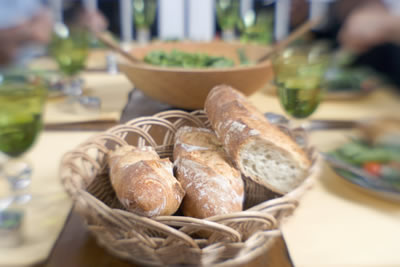| Bridge Trivia | |
This standard convention was originally called "Josephine." What convention is it?
Scroll down to find out. |
| Forward to a Friend |  | |
If you enjoy our Deal of the Week newsletter, why not forward it to a friend?
|
| Sign Up for Our Mailing List | |
If this newsletter was forwarded to you, sign up to be added to our mailing list.

|
The Daily Deal

Each day we "seed" one lesson deal somewhere into our otherwise randomly dealt set of boards. The board number is different each day. You never know which board it is. The daily deal is a free mini-lesson. You can take home a handout of the daily deal every day. We hope you find it educational as well as entertaining. To see past Daily Deals, click here. |
|
Sitouts Banned! 
We have done away with sit-outs, for once and for all. When we have a half-table in the game, we enter the computer as a participant in the game, in order to make a full table.
When it would otherwise be your turn to sit out, instead you play against the computer. Your score vs. the computer counts in the game. The computer is always disqualified, so it doesn't take away your masterpoints - in fact, the awards actually increase because the game is larger.
You can learn more about this here. |
|
Replay At Home  You can now replay the boards you've played at the club - in the comfort of your own home.
Replay the exact same hands with any of several commercial bridge programs such as GIB or Bridge Baron if you own one. If you have not purchased one, we have a free program for you to download. Click here for instructions. | |
|
Free Bridge Lessons

Rich answers your questions every Tuesday prior to the game. |
Thursdays, we have a vugraph presentation. Rich reviews interesting deals of the past week. Each board in question is projected onto our large video screen for all to see as we discuss it. |
|
Bridge Trivia Answer
In 1936, Ely Culbertson devised the Grand Slam Force as a means to locate the top trump honors whenever the partnership had the opportunity to attempt a grand slam.
After the partnership discovers that a small slam is a certainty, and that a grand slam is a possibility, a bid of 5NT by either partner asks the responder to bid a grand slam if he holds two of the top three trump honors.
This idea was first published in The Bridge World (a publication started by Ely Culbertson) by Culbertson's wife, Josephine. That's why the Grand Slam Force was originally called "Josephine." |
|
|
Continuing our series of famous bridge deals ...

The auction was straightforward, with South choosing a strong jump-shift response, then using Blackwood.
The opening lead was the  3 to East's 3 to East's  A. Declarer saw that he could avoid the club finesse if he could set up an extra heart trick, but that there could be problems with dummy entries if the trumps broke poorly. A. Declarer saw that he could avoid the club finesse if he could set up an extra heart trick, but that there could be problems with dummy entries if the trumps broke poorly.
He thoughtfully unblocked his  K under East's K under East's  A. East shifted to the A. East shifted to the  J, but declarer knew that setting up three heart tricks was a better bet than the club finesse, so he won his J, but declarer knew that setting up three heart tricks was a better bet than the club finesse, so he won his  A. A.
After drawing trumps, he used dummy's diamond honors as entries to trump two hearts in his hand and then discard his  Q on the established Q on the established  J. J.
So, you might have asked yourself, just what is so special about this deal?
Scroll down to see the rest of the story. |
 Free "End of Season" Luncheon |

On Monday, May 2, we will serve a special free gourmet lunch at 11:15 to celebrate the end of the tourist season.
Several of our most loyal players have offered to donate their time, money and cooking talents to make this possible. The menu will feature Nella's Risotto Alla Milanese - with prosciutto and portabella mushroom, salad, cheesecake and wine.
Please mark your calendars and plan to join us for this feast! |
 Peggy Goes "Over the Top" |
|
Congratulations to Peggy Muschett, who earned her final colored points last week at the Southeasterns. She actually became a Bronze Life Master at the same time!
We had a Life Master cake for her at Bridge Ace Monday. To make the day complete, Peggy and hubby Neville (in the background) came in first that day! |
 White House Bridge Player |
|
President Dwight D. Eisenhower showed his knowledge of bridge odds as declarer on this deal, which was the first bridge hand ever published in Time magazine. The hand was played in 1953 in a White House game. Eisenhower's partner was bridge expert Oswald Jacoby and their opponents were U.S. Chief Justice Fred Vinson and Air Force Secretary Harold Talbott.
Ike learned to play in 1913 at West Point and indulged his passion as he moved up the military ranks. He was dubbed the "bridge wizard of Manila" while he was stationed in the Philippines, where he played regularly with President Manuel Quezon. During WWII, an unwritten qualification for service on Eisenhower's staff was an officer's ability to play a decent game of bridge. His favorite partner was General Alfred Gruenther, regarded as the best bridge player in the U.S. Army, and they both took the game seriously. After one particularly disastrous result, they discussed the play of the hand in an exchange of letters that went on for two years.
Ike's bridge partnership with Gruenther had an impact on world history. After WWII, Eisenhower became president of Columbia University, an undemanding job that allowed him to spend every afternoon at his Manhattan bridge club. One day in 1948, he was called from the table to take a telephone call from President Harry Truman, who asked him to take the position as head of NATO in Paris. When he returned to the game, he told his bridge companions about the offer. "Who will you take as your 'number two' man?" they asked. ''Well, I ought to take Bedell Smith," replied Ike. "But I think I'll take Gruenther because he's the better bridge player.'' Gruenther later became the head of NATO when Eisenhower returned to the U.S. to run for president.
During his years as President, Eisenhower held regular Saturday-night games at the White House. The games were serious competitions, as Ike considered it a "sacrilege" to play bridge with anything less than total concentration. He was calm and thoughtful during the auction, but could become quite animated during the play of the hand. An old bridge friend described Ike's gusto when taking the setting trick: "The card rises vertically in the President's hand, then describes a 90-degree arc. It hits the table with a thump, upsetting ash trays and opponents."
Mamie Eisenhower loved the game, too. She and Ike rarely played together because he yelled at her when she made mistakes, but bridge was always the featured entertainment at her parties. When someone suggested that she invite Vice-President Nixon and his wife Pat to one of the weekend parties at the Eisenhowers' Gettysburg farm, Mamie rejected the idea. "What on earth would we talk about?" said Mamie. "She doesn't play bridge!"
How good a player was Ike? He wasn't an expert by today's standards, but bridge great Ely Culbertson described his game as "classic, sound, with flashes of brilliance." Oswald Jacoby, his frequent partner in the White House games, said, "The President plays better bridge than golf. He tries to break 90 at golf. At bridge, you would say he plays in the 70s." |
|
As always, you can follow the play of this deal with our Bridge Movie on our website. |
|
|
|
|